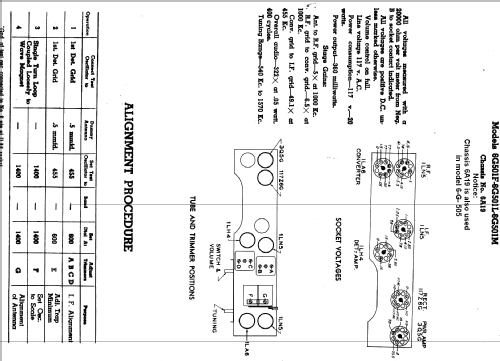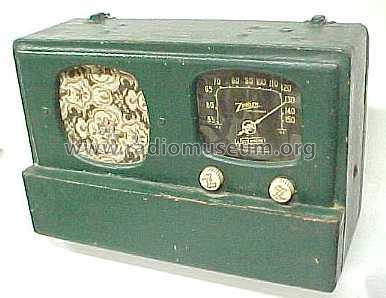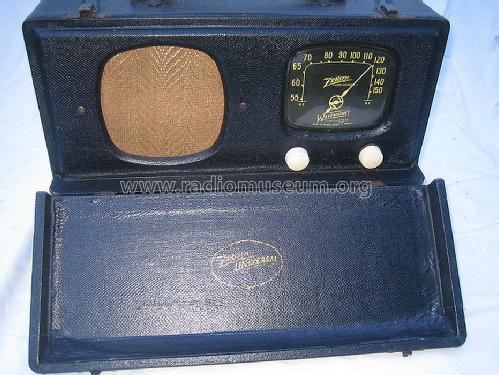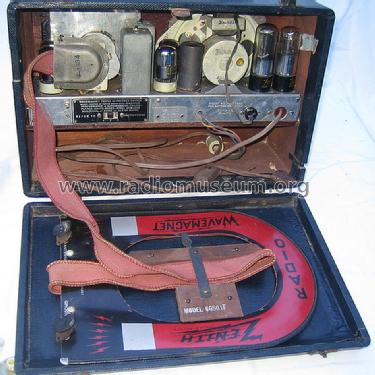6G501F Ch=6A19
Zenith Radio Corp.; Chicago, IL
- Land
- USA
- Hersteller / Marke
- Zenith Radio Corp.; Chicago, IL
- Jahr
- 1941
- Kategorie
- Rundfunkempfänger (Radio - oder Tuner nach WW2)
- Radiomuseum.org ID
- 67770
-
- anderer Name: Chicago Radio Lab
Klicken Sie auf den Schaltplanausschnitt, um diesen kostenlos als Dokument anzufordern.
- Anzahl Röhren
- 6
- Hauptprinzip
- Super mit HF-Vorstufe; ZF/IF 455 kHz
- Wellenbereiche
- Mittelwelle, keine anderen.
- Betriebsart / Volt
- Netz- / Batteriespeisung / 117; 90 & 9 Volt
- Lautsprecher
- Dynamischer LS, keine Erregerspule (permanentdynamisch) / Ø 5.5 inch = 14 cm
- Material
- Leder / Stoff / Plastic / Segeltuch über div. Material
- von Radiomuseum.org
- Modell: 6G501F Ch=6A19 - Zenith Radio Corp.; Chicago,
- Form
- Reisegerät > 20 cm (netzunabhängig betreibbar)
- Abmessungen (BHT)
- 381 x 249 x 178 mm / 15 x 9.8 x 7 inch
- Nettogewicht
- 6 kg / 13 lb 3.5 oz (13.216 lb)
- Originalpreis
- 29.95 USD
- Datenherkunft extern
- Ernst Erb
- Schaltungsnachweis
- Rider's Perpetual, Volume 12 = ca. 1941 and before
- Literaturnachweis
- Guide to Old Radios
- Weitere Modelle
-
Hier finden Sie 4517 Modelle, davon 4109 mit Bildern und 3653 mit Schaltbildern.
Alle gelisteten Radios usw. von Zenith Radio Corp.; Chicago, IL
Forumsbeiträge zum Modell: Zenith Radio Corp.;: 6G501F Ch=6A19
Threads: 1 | Posts: 7
Please be easy on me, this is my first radio post!
I have rebuilt a Zenith 6g501f. It functions perfectly on battery (actually quite outstanding), but on AC, it appears to have poor sensitivity to the point that the ACG runs the gain up and generates a lot of noise. There's no real hum and the power supply voltages look good - although the filament string voltage is noticeably lower on AC. The alignment also looks very good and the dial tracks remarkably well, far better than any of my transoceanics.
My first thought was that my wall voltage was low, but no, it's right between 116.5-117. The B+ looks good at 85-86V, the filament supply is around 7.9V. Checking the individual tube filaments, they are all around 1.35V (and ~2.8 on the 3q5g) which is very close to specification. I have fiddled with the power resistors and when I raise the filament to ~9 (essentially the same as on battery) it seems to get slightly better, but the required power resistors are down around 850 ohms (vice 1006 ohms per the schematic). I know from Transoceanics that the filament voltage can dramatically effect the performance but I am surprised that the standard voltages seem to result in such poor performance. I have tried several different sets of tubes, some NOS, with essentially no difference in the results. Does anyone in this august body have any better ideas?
Brett
Brett Buck, 06.Jan.11




